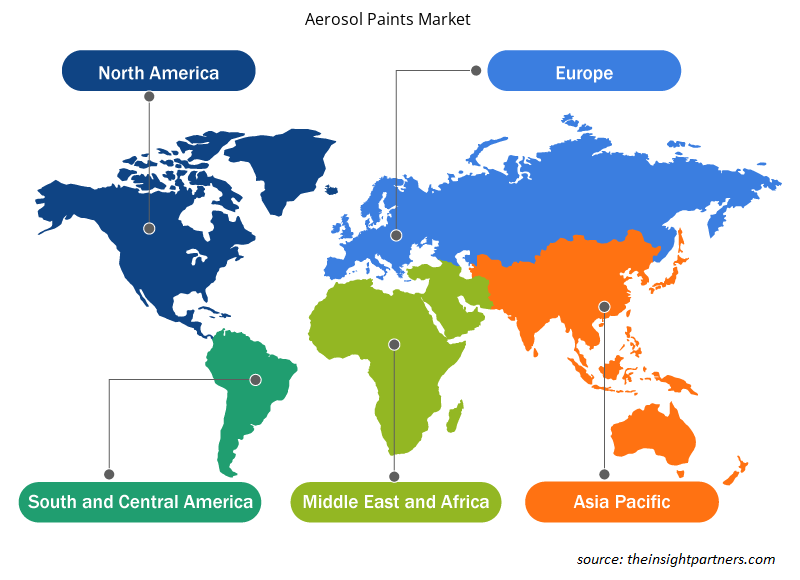[Forschungsbericht] Der globale Markt für Sprühfarben wurde im Jahr 2020 auf 3.941,90 Millionen US-Dollar geschätzt und soll bis 2028 5.238,49 Millionen US-Dollar erreichen; von 2021 bis 2028 wird ein durchschnittliches jährliches Wachstum von 3,9 % erwartet.
Aerosolfarben sind in versiegelten Druckbehältern erhältlich. Sie sind in verschiedenen Farben und Ausführungen erhältlich und daher bei Verbrauchern sehr beliebt. Sie werden häufig im Bau- und Automobilsektor verwendet, da sie einfach zu verwenden sind und schnell trocknen.
Im Jahr 2020 hatte der asiatisch-pazifische Raum den größten Anteil am globalen Markt für Sprühfarben . Es wird auch geschätzt, dass der Raum im Prognosezeitraum die schnellste CAGR des Marktes verzeichnen wird. Die Nachfrage nach Sprühfarben dürfte in der Region aufgrund verschiedener Faktoren wie der riesigen Bevölkerungsbasis, des steigenden verfügbaren Einkommens und des verbesserten Lebensstandards steigen. Das Wachstum des Marktes für Autoreparaturlacke hat ebenfalls positiv zum Wachstum der Nachfrage nach Sprühfarben im asiatisch-pazifischen Raum beigetragen. Diese Faktoren haben auch ausländische Akteure dazu bewogen, in die Region zu expandieren. Darüber hinaus ist das schnelle Wachstum dieser Region auch auf das Wachstum der Bauindustrie dort zurückzuführen. China ist der weltgrößte Baumarkt und wird in den nächsten Jahren voraussichtlich stark wachsen. Darüber hinaus werden auch andere Entwicklungsländer wie Indien voraussichtlich enorm wachsen, da der Schwerpunkt der Region auf der Ankurbelung der inländischen Produktionsaktivitäten liegt.
Der COVID-19-Ausbruch gilt als Pandemie und hat viele Unternehmen weltweit schwer getroffen. Die Pandemie hat die Produktions-, Logistik- sowie die Tourismus- und Reisebranche am stärksten beeinflusst. Der Virusausbruch veranlasste die Regierungen zahlreicher Länder, einen Lockdown zu verhängen, um die Ausbreitung des Virus einzudämmen. Daher haben viele Unternehmen Ausfallzeiten und müssen auf Fernarbeit umstellen, was zu geringerer Produktivität und Einkommen führt. Die Chemie- und Werkstoffindustrie ist einer der wichtigsten Sektoren, die aufgrund dieses Ausbruchs unter schweren Störungen wie Lieferkettenunterbrechungen, Absagen von Technologieveranstaltungen, Büroschließungen usw. leiden. Die anhaltende Pandemie hat die Bauindustrie vor mehrere Herausforderungen gestellt und die Weltwirtschaft gestört. Die globale Krise, eine Fortsetzung der Rezession und der Weg der Erholung werden hauptsächlich die Art und Schwere dieser Herausforderungen bestimmen. Die Bauindustrie, insbesondere das Segment für den Neubau von Wohngebäuden, entwickelte sich gut und erlebte im ersten Quartal 2020 in vielen Bereichen einen Aktivitätsschub. Aufgrund der steigenden Zahl der Fälle in Nordamerika wurden jedoch viele laufende Projekte, die von den Regierungsbehörden als unverzichtbar erachtet wurden, nicht gestoppt, aber die Baugenehmigungen für neue Wohngebäude wurden ausgesetzt. Darüber hinaus steht uns mit der Erklärung der Weltgesundheitsorganisation zur Pandemie des COVID-19-Ausbruchs eine beispiellose globale Störung bevor. Weltweit werden Automobil- und Komponentenfabriken geschlossen, die Kundenfrequenz in den Ausstellungsräumen ist stark zurückgegangen, die Fahrzeugverkäufe gehen dramatisch zurück und fast jede größere Branchenveranstaltung wird entweder abgesagt oder digital durchgeführt. Von nun an erfährt die Nachfrage nach Sprühfarben aufgrund der genannten Faktoren einen negativen Einfluss.
Passen Sie diesen Bericht Ihren Anforderungen an
Sie erhalten kostenlos individuelle Anpassungen an jedem Bericht, einschließlich Teilen dieses Berichts oder einer Analyse auf Länderebene, eines Excel-Datenpakets sowie tolle Angebote und Rabatte für Start-ups und Universitäten.
- Holen Sie sich die wichtigsten Markttrends aus diesem Bericht.Dieses KOSTENLOSE Beispiel umfasst eine Datenanalyse von Markttrends bis hin zu Schätzungen und Prognosen.
Markteinblicke
Zunehmende Verwendung von Sprühfarbe bei Heimwerkeraktivitäten
Do it Yourself (DIY) ist eine Aktivität, die das Dekorieren, Bauen, Modifizieren und Reparieren von Dingen zu Hause ohne die Hilfe eines Experten oder Profis umfasst. Verbraucher verwenden Sprühfarben für Heimwerkerarbeiten im Haushalt. Sie verwenden diese Farben, um ihre Möbel zu modernisieren oder neu zu gestalten, was ihnen hilft, die Kosten für neue Möbel zu sparen. Die Rahmen von Fenstern und Türen in Häusern können mit der Zeit abgenutzt werden und ihre Farben können auch durch UV-Strahlen ausbleichen. Die Holzrahmen können rau und unordentlich werden. Die Unterseite der Türrahmen wird durch ständigen Fußverkehr abgewetzt. Sprühfarben erfüllen daher einen doppelten Zweck, da sie die Fenster- und Türrahmen reparieren und modifizieren und den Möbeln ein neues Aussehen verleihen. Darüber hinaus hilft die Verwendung von Sprühfarben, die Kosten für den Kauf neuer Rahmen zu sparen. Türen haben Flecken und Kratzer und der Türstil kommt nach einiger Zeit aus der Mode. Es wird teuer, die Tür zu ersetzen. Sprühfarben können auch zur Herstellung verschiedener Kunst- und Handwerksprodukte verwendet werden. Sie können zum Bemalen von Toren und Zäunen verwendet werden. Die Sprühfarbe wird auch zum Malen von Wandgemälden verwendet. Wandgemälde werden mit Sprühfarben gemalt oder direkt auf eine Wand, Decke oder andere dauerhafte Oberflächen aufgetragen. Die Sprühfarben verleihen der Wandkunst eine tolle Wirkung und lassen sich auch leicht mit Schablonen verwenden. Daher treibt der zunehmende Einsatz von Sprühfarben bei Heimwerkeraktivitäten das Marktwachstum voran.
Einblicke in Rohstoffe
Basierend auf dem Rohmaterial ist der Markt für Sprühfarben in Acryl-, Alkyd-, Epoxid-, Polyurethan- und andere Farben unterteilt. Im Jahr 2020 dominierte das Alkydsegment den Markt für Sprühfarben. Alkydfarbe wird oft als ölbasierte Farbe beschrieben und enthält eine lösungsmittelbasierte Oberfläche. Diese Farben bestehen aus einem Polyesterharz und werden durch Trocknen von Fettsäuren und Pflanzenölen vernetzt. Das traditionelle Lösungsmittel für eine ölbasierte Farbe ist Lösungsbenzin. Lösungsbenzin ist zum Sprühen von Alkyd ungeeignet, es sei denn, es ist sehr heiß, da es zu langsam trocknet. Dieses langsam verdunstende Lösungsmittel hält die Farbe lange genug feucht, um beim Nivellieren zu helfen, weshalb ein schneller verdunstendes Lösungsmittel erwünscht ist. Die zunehmende Verwendung von Alkyd-Sprühfarben ist auf die einfache Anwendung und ein hochglänzendes Finish zurückzuführen, was das Nachfragewachstum auf dem Markt für Alkyd-Sprühfarben im Prognosezeitraum voraussichtlich ankurbeln wird.
Einige der wichtigsten Marktteilnehmer auf dem Markt für Sprühfarben sind Aeroaids Corporation; The Sherwin-Williams Company; Kobra Paint - Spray Art Technologies; Masterchem Industries LLC; MONTANA COLORS SL; Nippon Paint Holdings Co., Ltd.; Plutonium Paint; AVT Paints Pty Ltd; PPG Industries Inc.; Rust Oleum; Peter Kwasny GmbH; Motip Dupli Group BV; und Technima SAS. Wichtige Marktteilnehmer konzentrieren sich auf Strategien wie Fusionen und Übernahmen sowie Produkteinführungen, um die geografische Präsenz und die Kundenbasis zu erweitern.
Bericht-Spotlights
- Progressive Trends in der Sprühfarbenindustrie helfen den Akteuren bei der Entwicklung wirksamer langfristiger Strategien
- Von Unternehmen verfolgte Geschäftswachstumsstrategien zur Sicherung des Wachstums in entwickelten und sich entwickelnden Märkten
- Quantitative Analyse des globalen Marktes für Aerosolfarben von 2019 bis 2028
- Schätzung der Nachfrage nach Aerosolfarben in verschiedenen Branchen
- PEST-Analyse zur Veranschaulichung der Wirksamkeit der in der Branche tätigen Käufer und Lieferanten bei der Vorhersage des Marktwachstums
- Aktuelle Entwicklungen zum Verständnis des Wettbewerbsmarktszenarios und der Nachfrage nach Sprühfarben
- Markttrends und -aussichten in Verbindung mit Faktoren, die das Wachstum des Marktes für Sprühfarben vorantreiben und bremsen
- Verständnis der Strategien, die dem kommerziellen Interesse im Hinblick auf das Wachstum des globalen Marktes für Sprühfarben zugrunde liegen, als Unterstützung für den Entscheidungsprozess
- Aerosolfarben Marktgröße an verschiedenen Knotenpunkten des Marktes
- Detaillierte Übersicht und Segmentierung des globalen Marktes für Sprühfarben sowie seiner Branchendynamik
- Marktgröße für Aerosolfarben in verschiedenen Regionen mit vielversprechenden Wachstumschancen
Markt für Aerosolfarben nach Rohstoffen
- Acryl
- Alkyd
- Epoxid
- Polyurethan
- Sonstiges
Regionale Einblicke in den Markt für Sprühfarben
Die regionalen Trends und Faktoren, die den Markt für Aerosolfarben im Prognosezeitraum beeinflussen, wurden von den Analysten von Insight Partners ausführlich erläutert. In diesem Abschnitt werden auch die Marktsegmente und die Geografie für Aerosolfarben in Nordamerika, Europa, im asiatisch-pazifischen Raum, im Nahen Osten und Afrika sowie in Süd- und Mittelamerika erörtert.

- Holen Sie sich die regionalen spezifischen Daten für den Markt für Aerosolfarben
Umfang des Marktberichts für Aerosolfarben
| Berichtsattribut | Details |
|---|---|
| Marktgröße im Jahr 2020 | 3,94 Milliarden US-Dollar |
| Marktgröße bis 2028 | 5,24 Milliarden US-Dollar |
| Globale CAGR (2020 - 2028) | 3,9 % |
| Historische Daten | 2018-2019 |
| Prognosezeitraum | 2021-2028 |
| Abgedeckte Segmente | Nach Rohmaterial
|
| Abgedeckte Regionen und Länder | Nordamerika
|
| Marktführer und wichtige Unternehmensprofile |
|
Dichte der Marktteilnehmer für Aerosolfarben: Auswirkungen auf die Geschäftsdynamik verstehen
Der Markt für Aerosolfarben wächst rasant, angetrieben durch die steigende Nachfrage der Endverbraucher aufgrund von Faktoren wie sich entwickelnden Verbraucherpräferenzen, technologischen Fortschritten und einem größeren Bewusstsein für die Vorteile des Produkts. Mit steigender Nachfrage erweitern Unternehmen ihr Angebot, entwickeln Innovationen, um die Bedürfnisse der Verbraucher zu erfüllen, und nutzen neue Trends, was das Marktwachstum weiter ankurbelt.
Die Marktteilnehmerdichte bezieht sich auf die Verteilung der Firmen oder Unternehmen, die in einem bestimmten Markt oder einer bestimmten Branche tätig sind. Sie gibt an, wie viele Wettbewerber (Marktteilnehmer) in einem bestimmten Marktraum im Verhältnis zu seiner Größe oder seinem gesamten Marktwert präsent sind.
Die wichtigsten auf dem Markt für Sprühfarben tätigen Unternehmen sind:
- Aeroaids Corporation
- Die Sherwin-Williams Company
- Kobra Paint - Spray Art Technologien
- Masterchem Industries LLC
- Dieses Unternehmen wird von MONTANA COLORS SL betrieben.
Haftungsausschluss : Die oben aufgeführten Unternehmen sind nicht in einer bestimmten Reihenfolge aufgeführt.

- Überblick über die wichtigsten Akteure auf dem Markt für Aerosolfarben
Markt für Aerosolfarben nach Technologie
- Auf Lösungsmittelbasis
- Auf Wasserbasis
- Sonstiges
Aerosolfarbenmarkt, nach Anwendung
- Bauindustrie
- Automobil und Transport
- Holz- und Möbelindustrie
- Verpackung
- Sonstiges
Firmenprofile
- Aeroaids Corporation
- Die Sherwin-Williams Company
- Kobra Paint - Spray Art Technologien
- Masterchem Industries LLC
- Dieses Unternehmen wird von MONTANA COLORS SL betrieben.
- Nippon Paint Holdings Co., Ltd.
- Plutoniumfarbe
- AVT Paints Pty Ltd
- PPG Industries Inc.
- Rost-Oleum
- Peter Kwasny GmbH
- Motip Dupli Group BV
- Technima SAS
- Historische Analyse (2 Jahre), Basisjahr, Prognose (7 Jahre) mit CAGR
- PEST- und SWOT-Analyse
- Marktgröße Wert/Volumen – Global, Regional, Land
- Branche und Wettbewerbsumfeld
- Excel-Datensatz



Report Coverage
Revenue forecast, Company Analysis, Industry landscape, Growth factors, and Trends

Segment Covered
This text is related
to segments covered.

Regional Scope
North America, Europe, Asia Pacific, Middle East & Africa, South & Central America

Country Scope
This text is related
to country scope.
Häufig gestellte Fragen
Acrylic paints can be used in versatile applications and is relatively less toxic. They are mostly water-based and have short drying times. It can be painted on different surfaces such as steel, plastic, wood and others. These factors are expected to aid the adoption of acrylic aerosol paints.
Aerosol paints are available in pressurized containers in various colors and styles. They are widely used in architectural decoration, automotive refinish and custom painting, wood finishing and many other applications.
Based, on raw material, the aerosol paints market is segmented into acrylic, alkyd, epoxy, polyurethane, and others. Technology segmentation includes solvent-borne, water-borne, and others. Based on application, the global aerosol paints market is segmented into construction industry, automotive and transportation, wood and furniture industry, packaging, and others.
The major players operating in the global aerosol paints market are Aeroaids Corporation; The Sherwin-Williams Company; Kobra Paint - Spray Art Technologies; Masterchem Industries LLC; MONTANA COLORS S.L.; Nippon Paint Holdings Co., Ltd.; Plutonium Paint; AVT Paints Pty Ltd; PPG Industries Inc.; Rust Oleum; Peter Kwasny GmbH; Motip Dupli Group B.V.; and Technima SAS among many others.
Trends and growth analysis reports related to Chemicals and Materials : READ MORE..
The List of Companies - Aerosol Paints Market
- Aeroaids Corporation
- The Sherwin-Williams Company
- Kobra Paint - Spray Art Technologies
- Masterchem Industries LLC
- MONTANA COLORS S.L.
- Nippon Paint Holdings Co., Ltd.
- Plutonium Paint
- AVT Paints Pty Ltd
- PPG Industries Inc.
- Rust Oleum
The Insight Partners performs research in 4 major stages: Data Collection & Secondary Research, Primary Research, Data Analysis and Data Triangulation & Final Review.
- Data Collection and Secondary Research:
As a market research and consulting firm operating from a decade, we have published and advised several client across the globe. First step for any study will start with an assessment of currently available data and insights from existing reports. Further, historical and current market information is collected from Investor Presentations, Annual Reports, SEC Filings, etc., and other information related to company’s performance and market positioning are gathered from Paid Databases (Factiva, Hoovers, and Reuters) and various other publications available in public domain.
Several associations trade associates, technical forums, institutes, societies and organization are accessed to gain technical as well as market related insights through their publications such as research papers, blogs and press releases related to the studies are referred to get cues about the market. Further, white papers, journals, magazines, and other news articles published in last 3 years are scrutinized and analyzed to understand the current market trends.
- Primary Research:
The primarily interview analysis comprise of data obtained from industry participants interview and answers to survey questions gathered by in-house primary team.
For primary research, interviews are conducted with industry experts/CEOs/Marketing Managers/VPs/Subject Matter Experts from both demand and supply side to get a 360-degree view of the market. The primary team conducts several interviews based on the complexity of the markets to understand the various market trends and dynamics which makes research more credible and precise.
A typical research interview fulfils the following functions:
- Provides first-hand information on the market size, market trends, growth trends, competitive landscape, and outlook
- Validates and strengthens in-house secondary research findings
- Develops the analysis team’s expertise and market understanding
Primary research involves email interactions and telephone interviews for each market, category, segment, and sub-segment across geographies. The participants who typically take part in such a process include, but are not limited to:
- Industry participants: VPs, business development managers, market intelligence managers and national sales managers
- Outside experts: Valuation experts, research analysts and key opinion leaders specializing in the electronics and semiconductor industry.
Below is the breakup of our primary respondents by company, designation, and region:

Once we receive the confirmation from primary research sources or primary respondents, we finalize the base year market estimation and forecast the data as per the macroeconomic and microeconomic factors assessed during data collection.
- Data Analysis:
Once data is validated through both secondary as well as primary respondents, we finalize the market estimations by hypothesis formulation and factor analysis at regional and country level.
- Macro-Economic Factor Analysis:
We analyse macroeconomic indicators such the gross domestic product (GDP), increase in the demand for goods and services across industries, technological advancement, regional economic growth, governmental policies, the influence of COVID-19, PEST analysis, and other aspects. This analysis aids in setting benchmarks for various nations/regions and approximating market splits. Additionally, the general trend of the aforementioned components aid in determining the market's development possibilities.
- Country Level Data:
Various factors that are especially aligned to the country are taken into account to determine the market size for a certain area and country, including the presence of vendors, such as headquarters and offices, the country's GDP, demand patterns, and industry growth. To comprehend the market dynamics for the nation, a number of growth variables, inhibitors, application areas, and current market trends are researched. The aforementioned elements aid in determining the country's overall market's growth potential.
- Company Profile:
The “Table of Contents” is formulated by listing and analyzing more than 25 - 30 companies operating in the market ecosystem across geographies. However, we profile only 10 companies as a standard practice in our syndicate reports. These 10 companies comprise leading, emerging, and regional players. Nonetheless, our analysis is not restricted to the 10 listed companies, we also analyze other companies present in the market to develop a holistic view and understand the prevailing trends. The “Company Profiles” section in the report covers key facts, business description, products & services, financial information, SWOT analysis, and key developments. The financial information presented is extracted from the annual reports and official documents of the publicly listed companies. Upon collecting the information for the sections of respective companies, we verify them via various primary sources and then compile the data in respective company profiles. The company level information helps us in deriving the base number as well as in forecasting the market size.
- Developing Base Number:
Aggregation of sales statistics (2020-2022) and macro-economic factor, and other secondary and primary research insights are utilized to arrive at base number and related market shares for 2022. The data gaps are identified in this step and relevant market data is analyzed, collected from paid primary interviews or databases. On finalizing the base year market size, forecasts are developed on the basis of macro-economic, industry and market growth factors and company level analysis.
- Data Triangulation and Final Review:
The market findings and base year market size calculations are validated from supply as well as demand side. Demand side validations are based on macro-economic factor analysis and benchmarks for respective regions and countries. In case of supply side validations, revenues of major companies are estimated (in case not available) based on industry benchmark, approximate number of employees, product portfolio, and primary interviews revenues are gathered. Further revenue from target product/service segment is assessed to avoid overshooting of market statistics. In case of heavy deviations between supply and demand side values, all thes steps are repeated to achieve synchronization.
We follow an iterative model, wherein we share our research findings with Subject Matter Experts (SME’s) and Key Opinion Leaders (KOLs) until consensus view of the market is not formulated – this model negates any drastic deviation in the opinions of experts. Only validated and universally acceptable research findings are quoted in our reports.
We have important check points that we use to validate our research findings – which we call – data triangulation, where we validate the information, we generate from secondary sources with primary interviews and then we re-validate with our internal data bases and Subject matter experts. This comprehensive model enables us to deliver high quality, reliable data in shortest possible time.


 Holen Sie sich ein kostenloses Muster für diesen Bericht
Holen Sie sich ein kostenloses Muster für diesen Bericht